Mining-Induced Earthquake Risk Assessment and Control Strategy Based on Microseismic and Stress Monitoring: A Case Study of Chengyang Coal Mine
Abstract
1. Introduction
2. Engineering Background
2.1. Overview of the Working Face
2.2. Monitoring System and Sensor Arrangement
3. Overview and Mechanism of Mining-Induced Earthquake Events at the 3308 Working Face
3.1. Overview of Mining-Induced Earthquake Events
3.2. Analysis of Mine Pressure Manifestations in Roadways Before and After High-Energy Mining-Induced Earthquakes
3.3. Analysis of Microseismic Activity Patterns Before and After High-Energy Mining-Induced Earthquakes
3.3.1. Time-Frequency Analysis of Microseismic Activity Patterns Before and After High-Energy Mining-Induced Earthquakes
3.3.2. Calculation of Mining-Induced Earthquake Source Mechanism
3.4. Analysis of the Mechanism of High-Energy Mining-Induced Earthquake Events
- (1)
- For the high-energy mining-induced earthquake event on 10 September:
- (2)
- For the high-energy mining-induced earthquake event on 10 September:
4. Risk Assessment and Countermeasures for Mining-Induced Earthquake at the 3308 Working Face
4.1. Key Management Areas for Mining-Induced Earthquake
- (1)
- High-Risk Management Area: Within 100 m of the initial extraction track roadway, belt roadway, and cutout. This area is delineated due to its proximity to the DF60 fault, a major stress concentration zone in the Yangcheng Coal Mine. Microseismic monitoring data show that both previous high-energy mining-induced earthquake events occurred near this area, indicating a strong energy accumulation trend. Additionally, during initial extraction, mining disturbances can easily activate the fault, triggering high-energy mining-induced earthquake events and elevating the area’s risk. Stress monitoring results indicate significant stress concentration in this area, and fault slippage is highly susceptible to influence. For example, Tang [38] analyzed the mechanical mechanisms of fault activation using numerical simulation and theoretical analysis. They studied the interaction between mining stress and fault activation and explored the impact of fault dip angle on fault rupture activation and the evolution of mining stress. Therefore, this area is designated a high-risk management zone for mining-induced earthquake events.
- (2)
- High-Risk Management Area within 100–200 m of the Cutout in the Track Roadway: This area, adjacent to the cutout, is influenced by stress conduction from the primary stress transmission, with notable initial extraction stress concentration effects, creating a high mining-induced earthquake risk. The primary stress transmission mechanism keeps the stress level in this area elevated, with microseismic monitoring data indicating frequent high-energy mining-induced earthquake events and a clear energy accumulation trend. According to the stress attenuation formula, although stress gradually decreases with distance from the cutout, it remains highly concentrated within this range. Zhang et al. [39] conducted a simulation study on the displacement, stress, and distribution of the plastic zone near the fault in the roadway. Therefore, strong management measures should be implemented here to effectively prevent seismic hazards.
- (3)
- Low-Risk Management Area within 250–350 Meters of the Cutout in the Track Roadway: Due to the attenuation effect of primary stress transmission, stress levels in this area gradually decrease. According to the stress attenuation formula, stress exhibits an exponential decay with increasing distance from the cutout, resulting in lower stress levels within this region. Additionally, historical microseismic monitoring data indicate significantly lower energy and frequency of microseismic events in this area compared to high-risk zones, suggesting limited energy accumulation and defining it as a secondary risk zone. Being farther from major faults, this area is less affected by structural stress, making it a low-risk zone overall.
- (4)
- High-Risk Management Area within 250–350 Meters of the Cutout in the Belt roadway, Coupled with DF56 Fault: This area is designated due to the strong influence of the DF56 fault, which has a high risk of slippage. Mining activities may induce fault slippage, causing intense fluctuations in the local stress field. Microseismic monitoring results show increased frequency and energy of microseismic events in this region, with pronounced stress accumulation near the fault. Consequently, this area poses a high risk for induced mining-induced earthquake events and should be considered a high-risk management zone.
- (5)
- High-Risk Management Area within 430–500 Meters of the Cutout in the Track Roadway, Near FD34 Fault: This area is adjacent to the FD34 fault, which exhibits a significant structural stress concentration effect. Historical monitoring data indicate that slippage along the FD34 fault may trigger high-energy mining-induced earthquake events. Feng et al. [41] investigated the effects of fault dip angle (θ), fault strike angle (φ), fault zone width (d), and the distance between the working face and the fault (l) on the spatiotemporal evolution of stress and elastic potential energy. As extraction progresses, the likelihood of fault slippage increases. Microseismic monitoring results show frequent fracturing events with high energy levels, suggesting a substantial potential for mining-induced earthquakes; therefore, this area is designated as a high-risk management zone.
- (6)
- Low-Risk Management Area within 350–780 Meters of the Cutout in the Belt roadway, Near DF56 Fault: Although this area is near the DF56 fault, its considerable distance from the fault results in minimal stress concentration influence. Microseismic monitoring data show significantly lower energy and frequency of microseismic events in this area compared to other high-risk zones, with limited localized stress accumulation, indicating low seismic risk. However, given the potential for stress transmission, ongoing monitoring is still necessary, and thus, this area is designated as a low-risk management zone.
4.2. Recommendations for Mining-Induced Earthquake Prevention and Control
- (1)
- Optimize sensor networks to enhance the accuracy of microseismic localization.
- (2)
- Strengthen technical training to improve the data processing skills of personnel in microseismic and stress monitoring.
- (3)
- Adjust the working face layout to avoid the influence area of fault-protected coal pillars and redesign the cutout position; consider relocating the belt roadway layout to avoid proximity to the DF56 fault.
- (4)
- Drill high-level roof boreholes toward the goaf and fault-protected coal pillar along the 3308 track roadway for pressure relief, using hydraulic fracturing and deep-hole blasting to alleviate stress in the fault-protected coal pillar while caving in the goaf area to interrupt support pressure transmission.
- (5)
- Analyze microseismic data in-depth to ensure timely responses.
- (6)
- Optimize extraction speed and recalculate support pressures, reinforcing supports if necessary.
- (7)
- Enhance support and monitoring in key management areas, implementing timely pressure relief, caving, and other measures to prevent rockburst hazards.
5. Conclusions
- (1)
- A single monitoring method has significant limitations in analyzing precursors of high-energy mining-induced earthquakes and identifying hazardous areas. Although microseismic monitoring can provide information on the location and energy of fracture events within the coal-rock mass, it has difficulty directly reflecting the dynamic changes in stress concentration around the roadway surrounding rock, making it challenging to identify risk characteristics of stress accumulation zones. Meanwhile, while the coal body stress monitoring system is highly sensitive and can capture local stress changes, it cannot effectively capture the spatial distribution of fractures and mining-induced earthquake events or their temporal occurrence patterns. As a result, it is difficult to obtain complete precursor information. These limitations make it challenging for a single monitoring approach to comprehensively identify precursors of high-energy mining-induced earthquakes and to accurately delineate potential high-risk areas, thus constraining the effectiveness of mining-induced earthquake prevention and control.
- (2)
- Through integrated analysis of stress monitoring and microseismic data, the primary controlling factors of high-energy mining-induced earthquake events at the 3308 working face were identified, including stress fluctuations in high-stress concentration zones and activation of the DF60 fault and its protected coal pillar. The monitored “silent period” preceding high-energy mining-induced earthquake events indicated internal energy accumulation, a critical precursor signal for mining-induced earthquake events. Source mechanism analysis confirmed that the fracture mode of mining-induced earthquake events aligns with fault slippage characteristics.
- (3)
- By conducting comprehensive multi-parameter data analysis, the spatial-temporal evolution characteristics of high-energy mining-induced earthquake events were determined, and a method for identifying high-risk areas was proposed, leading to the delineation of high-risk management zones for mining-induced earthquake events. Measures such as dynamic pressure relief drilling and deep-hole blasting were implemented. Practical results demonstrate that the integrated hazard identification method and control measures combining microseismic and stress monitoring effectively mitigated high-energy mining-induced earthquake events, providing reliable assurance for safe production in deep coal mining.
Author Contributions
Funding
Institutional Review Board Statement
Informed Consent Statement
Data Availability Statement
Conflicts of Interest
References
- Tomassi, A.; Trippetta, F.; de Franco, R.; Ruggieri, R. From Petrophysical Properties to Forward-Seismic Modeling of Facies Heterogeneity in the Carbonate Realm (Majella Massif, Central Italy). J. Pet. Sci. Eng. 2022, 211, 110242. [Google Scholar] [CrossRef]
- Lyu, P.; Geng, Y. Unified Mechanism of Rock Burst Induced by Coal Mine Earthquake and Its Activity and Response Characteristics. Shock. Vib. 2023, 2023, 2145765. [Google Scholar] [CrossRef]
- Li, T.; Cai, M.F.; Cai, M. A Review of Mining-Induced Seismicity in China. Int. J. Rock Mech. Min. Sci. 2007, 44, 1149–1171. [Google Scholar] [CrossRef]
- Chen, D.; Wang, Z.; Yue, S.; Xie, S.; He, F.; Tian, C.; Jiang, Z.; Liang, D.; Qi, B. Study on Surrounding Rock Control of Withdrawal Space in Fully Mechanized Caving Mining of a 19 m Extra-Thick Coal Seam. Appl. Sci. 2024, 14, 9694. [Google Scholar] [CrossRef]
- Zhang, C.; Jin, G.; Liu, C.; Li, S.; Xue, J.; Cheng, R.; Wang, X.; Zeng, X. Prediction of Rockbursts in a Typical Island Working Face of a Coal Mine through Microseismic Monitoring Technology. Tunn. Undergr. Space Technol. 2021, 113, 103972. [Google Scholar] [CrossRef]
- Li, X.; Chen, S.; Wang, E.; Li, Z. Rockburst Mechanism in Coal Rock with Structural Surface and the Microseismic (MS) and Electromagnetic Radiation (EMR) Response. Eng. Fail. Anal. 2021, 124, 105396. [Google Scholar] [CrossRef]
- Zhao, J.-S.; Jiang, Q.; Lu, J.-F.; Chen, B.-R.; Pei, S.-F.; Wang, Z.-L. Rock Fracturing Observation Based on Microseismic Monitoring and Borehole Imaging: In Situ Investigation in a Large Underground Cavern under High Geostress. Tunn. Undergr. Space Technol. 2022, 126, 104549. [Google Scholar] [CrossRef]
- Lu, C.-P.; Dou, L.-M.; Zhang, N.; Xue, J.-H.; Wang, X.-N.; Liu, H.; Zhang, J.-W. Microseismic Frequency-Spectrum Evolutionary Rule of Rockburst Triggered by Roof Fall. Int. J. Rock Mech. Min. Sci. 2013, 64, 6–16. [Google Scholar] [CrossRef]
- Liu, X.; Zhang, Z.; Wang, E.; Wang, X.; Yang, B.; Wang, H. Characteristics of Electromagnetic Radiation Signal of Coal and Rock under Uniaxial Compression and Its Field Application. J. Earth Syst. Sci. 2019, 129, 34. [Google Scholar] [CrossRef]
- Li, H.; Qiao, Y.; Shen, R.; He, M. Electromagnetic Radiation Signal Monitoring and Multi-Fractal Analysis during Uniaxial Compression of Water-Bearing Sandstone. Measurement 2022, 196, 111245. [Google Scholar] [CrossRef]
- Ma, K.; Wang, H.; Liao, Z.; Peng, Y.; Wang, K. Precursor of Microseismic Energy and Stress Evolution Induced by Rockburst in Coal Mining: A Case Study from Xiashijie, Shannxi, China. Geomech. Geophys. Geo-Energy Geo-Resour. 2022, 8, 134. [Google Scholar] [CrossRef]
- Zhan, K.; Wen, X.; Wang, X.; Kong, C. A Method for Characterization of Stress Concentration Degree of Coal Mine Roadway Surrounding Rock. J. Geophys. Eng. 2023, 20, 699–711. [Google Scholar] [CrossRef]
- Liu, C.; Zhao, G.; Xu, W.; Meng, X.; Huang, S.; Zhou, J.; Wang, Y. Experimental Investigation on Failure Process and Spatio-Temporal Evolution of Rockburst in Granite with a Prefabricated Circular Hole. J. Cent. South Univ. 2020, 27, 2930–2944. [Google Scholar] [CrossRef]
- Yin, S.; Li, Z.; Wang, E.; Liu, Y.; Niu, Y.; Yang, H. Damage Status and Failure Precursors of Different Coal Impact Types Based on Comprehensive Monitoring of Infrared Radiation and Acoustic Emission. Appl. Sci. 2024, 14, 8792. [Google Scholar] [CrossRef]
- Wang, J.; Apel, D.B.; Xu, H.; Wei, C.; Skrzypkowski, K. Evaluation of the Effects of Yielding Rockbolts on Controlling Self-Initiated Strainbursts: A Numerical Study. Energies 2022, 15, 2574. [Google Scholar] [CrossRef]
- Barthwal, H.; van der Baan, M. Microseismicity Observed in an Underground Mine: Source Mechanisms and Possible Causes. Géoméch. Energy Environ. 2020, 22, 100167. [Google Scholar] [CrossRef]
- Holub, K.; Rušajová, J.; Holečko, J. Particle Velocity Generated by Rockburst during Exploitation of the Longwall and Its Impact on the Workings. Int. J. Rock Mech. Min. Sci. 2011, 48, 942–949. [Google Scholar] [CrossRef]
- Dou, L.; Chen, T.; Gong, S.; He, H.; Zhang, S. Rockburst Hazard Determination by Using Computed Tomography Technology in Deep Workface. Saf. Sci. 2012, 50, 736–740. [Google Scholar] [CrossRef]
- Yan, X.; Xu, R.; Zhan, K.; Wen, X.; Wang, C.; Li, Z.; Zhang, Q. Inversion of Mining-Induced Stress Field Based on Focal Mechanism Solutions: A Case Study of the 63upper06 Working Face in Dongtan Coal Mine. Front. Earth Sci. 2024, 12, 1405154. [Google Scholar] [CrossRef]
- Moment Tensor Inversion and Stress Evolution of Coal Pillar Failure Mechanism|Rock Mechanics and Rock Engineering. Available online: https://link.springer.com/article/10.1007/s00603-022-02783-1 (accessed on 10 October 2024).
- He, S.; Song, D.; Li, Z.; He, X.; Chen, J.; Li, D.; Tian, X. Precursor of Spatio-Temporal Evolution Law of MS and AE Activities for Rock Burst Warning in Steeply Inclined and Extremely Thick Coal Seams Under Caving Mining Conditions. Rock Mech. Rock Eng. 2019, 52, 2415–2435. [Google Scholar] [CrossRef]
- Liu, X.; Zhang, S.; Wang, E.; Zhang, Z.; Wang, Y.; Yang, S. Multi-Index Geophysical Monitoring and Early Warning for Rockburst in Coalmine: A Case Study. Int. J. Environ. Res. Public Health 2023, 20, 392. [Google Scholar] [CrossRef]
- Li, X.; Wang, E.; Li, Z.; Liu, Z.; Song, D.; Qiu, L. Rock Burst Monitoring by Integrated Microseismic and Electromagnetic Radiation Methods. Rock Mech. Rock Eng. 2016, 49, 4393–4406. [Google Scholar] [CrossRef]
- Li, Z.; Dou, L.; Cai, W.; Wang, G.; He, J.; Gong, S.; Ding, Y. Investigation and Analysis of the Rock Burst Mechanism Induced within Fault-Pillars. Int. J. Rock Mech. Min. Sci. 2014, 70, 192–200. [Google Scholar] [CrossRef]
- He, M.C.; Zhao, F.; Cai, M.; Du, S. A Novel Experimental Technique to Simulate Pillar Burst in Laboratory. Rock Mech. Rock Eng. 2015, 48, 1833–1848. [Google Scholar] [CrossRef]
- Liu, X.; Xu, G.; Zhang, C.; Kong, B.; Qian, J.; Zhu, D.; Wei, M. Time Effect of Water Injection on the Mechanical Properties of Coal and Its Application in Rockburst Prevention in Mining. Energies 2017, 10, 1783. [Google Scholar] [CrossRef]
- He, J.; Dou, L.; Gong, S.; Li, J.; Ma, Z. Rock Burst Assessment and Prediction by Dynamic and Static Stress Analysis Based on Micro-Seismic Monitoring. Int. J. Rock Mech. Min. Sci. 2017, 93, 46–53. [Google Scholar] [CrossRef]
- Guo, W.; Ma, X.; Wen, Y.; Cao, X. Stress Evolution and Rock Burst Prevention in Triangle Coal Pillars under the Influence of Penetrating Faults: A Case Study. Appl. Sci. 2024, 14, 8585. [Google Scholar] [CrossRef]
- Zhu, S.; Feng, Y.; Jiang, F. Determination of Abutment Pressure in Coal Mines with Extremely Thick Alluvium Stratum: A Typical Kind of Rockburst Mines in China. Rock Mech. Rock Eng. 2016, 49, 1943–1952. [Google Scholar] [CrossRef]
- Zhu, S.; Feng, Y.; Jiang, F.; Liu, J. Mechanism and Risk Assessment of Overall-Instability-Induced Rockbursts in Deep Island Longwall Panels. Int. J. Rock Mech. Min. Sci. 2018, 106, 342–349. [Google Scholar] [CrossRef]
- Howe, M.; Ekstrom, G.; Nettles, M. Improving Relative Earthquake Locations Using Surface-Wave Source Corrections. Geophys. J. Int. 2019, 219, 297–312. [Google Scholar] [CrossRef]
- Monteiller, V.; Got, J.L.; Virieux, J.; Okubo, P. An Efficient Algorithm for Double-Difference Tomography and Location in Heterogeneous Media, with an Application to the Kilauea Volcano. J. Geophys. Res.-Solid Earth 2005, 110, B12306. [Google Scholar] [CrossRef]
- Zhu, L.; Ben-Zion, Y. Parametrization of General Seismic Potency and Moment Tensors for Source Inversion of Seismic Waveform Data. Geophys. J. Int. 2013, 194, 839–843. [Google Scholar] [CrossRef]
- Okubo, K.; Bhat, H.S.; Rougier, E.; Marty, S.; Schubnel, A.; Lei, Z.; Knight, E.E.; Klinger, Y. Dynamics, Radiation, and Overall Energy Budget of Earthquake Rupture With Coseismic Off-Fault Damage. J. Geophys. Res.-Solid Earth 2019, 124, 11771–11801. [Google Scholar] [CrossRef]
- Ekström, G.; Dziewonski, A.M. Evidence of Bias in Estimations of Earthquake Size. Nature 1988, 332, 319–323. [Google Scholar] [CrossRef]
- Duan, J.; Shum, C.K.; Guo, J.; Huang, Z. Uncovered Spurious Jumps in the GRACE Atmospheric De-Aliasing Data: Potential Contamination of GRACE Observed Mass Change. Geophys. J. Int. 2012, 191, 83–87. [Google Scholar] [CrossRef]
- Julian, B.R.; Miller, A.D.; Foulger, G.R. Non-Double-Couple Earthquakes 1. Theory. Rev. Geophys. 1998, 36, 525–549. [Google Scholar] [CrossRef]
- Tang, L.; Tu, S.; Tu, H.; Zhang, L.; Miao, K.; Zhao, H.; Ma, J. Interaction Law between Mining Stress and Fault Activation and the Effect of Fault Dip Angle in Longwall Working Face. Sci. Rep. 2024, 14, 25654. [Google Scholar] [CrossRef] [PubMed]
- Zhang, Z.; Chen, F.; Li, N.; He, M. Influence of Fault on the Surrounding Rock Stability for a Mining Tunnel: Distance and Tectonic Stress. Adv. Civ. Eng. 2019, 2019, 2054938. [Google Scholar] [CrossRef]
- Butcher, A.; Luckett, R.; Kendall, J.-M.; Baptie, B. Seismic Magnitudes, Corner Frequencies, and Microseismicity: Using Ambient Noise to Correct for High-Frequency Attenuation. Bull. Seismol. Soc. Amer. 2020, 110, 1260–1275. [Google Scholar] [CrossRef]
- Feng, X.; Zhao, X.; Ding, Z.; Hu, Q.; Wang, D.; Cao, Z. Numerical Study on the Influence of Fault Orientation on Risk Level of Fault Slip Burst Disasters in Coal Mines: A Quantitative Evaluation Model. Environ. Earth Sci. 2024, 83, 94. [Google Scholar] [CrossRef]
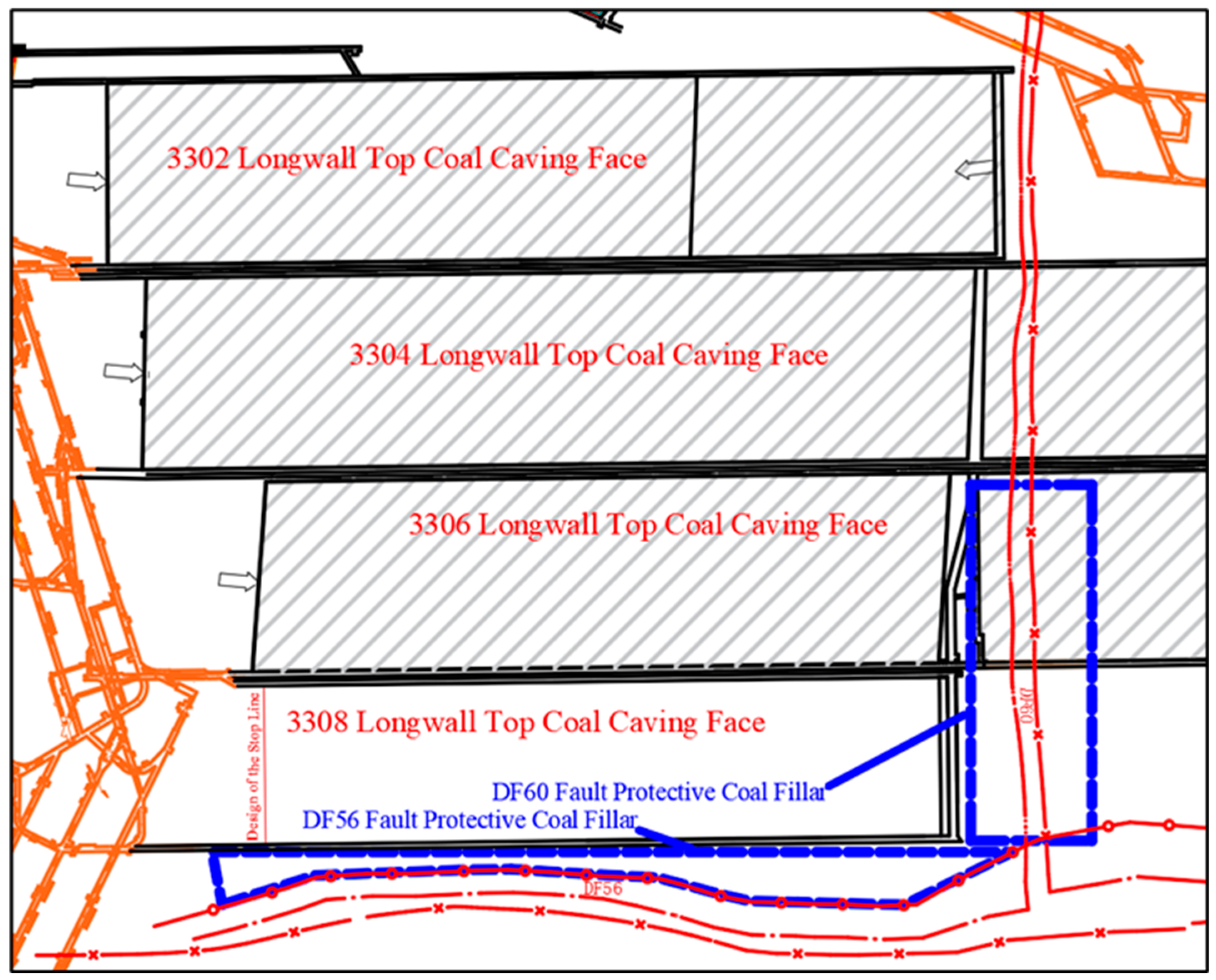

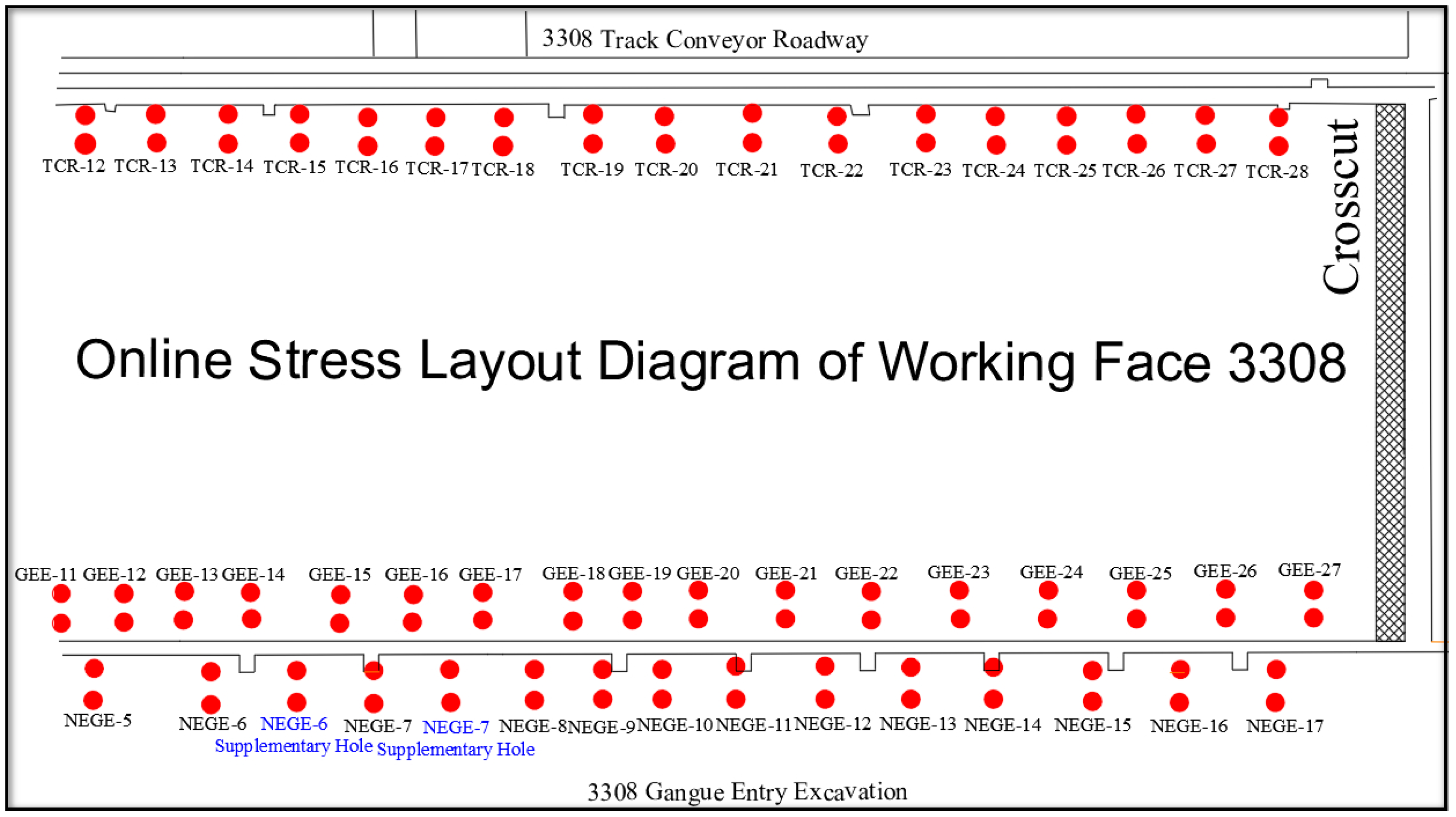
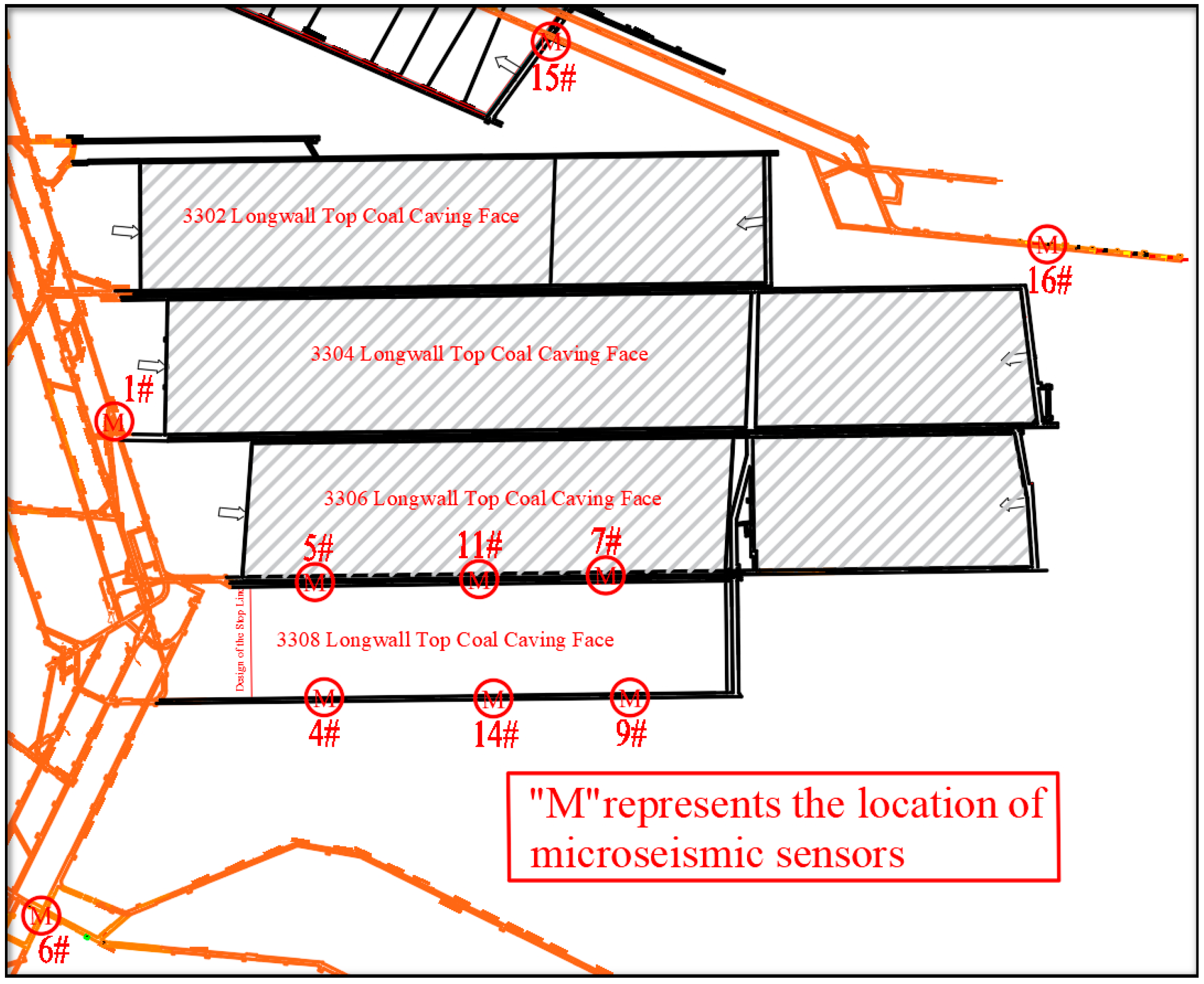
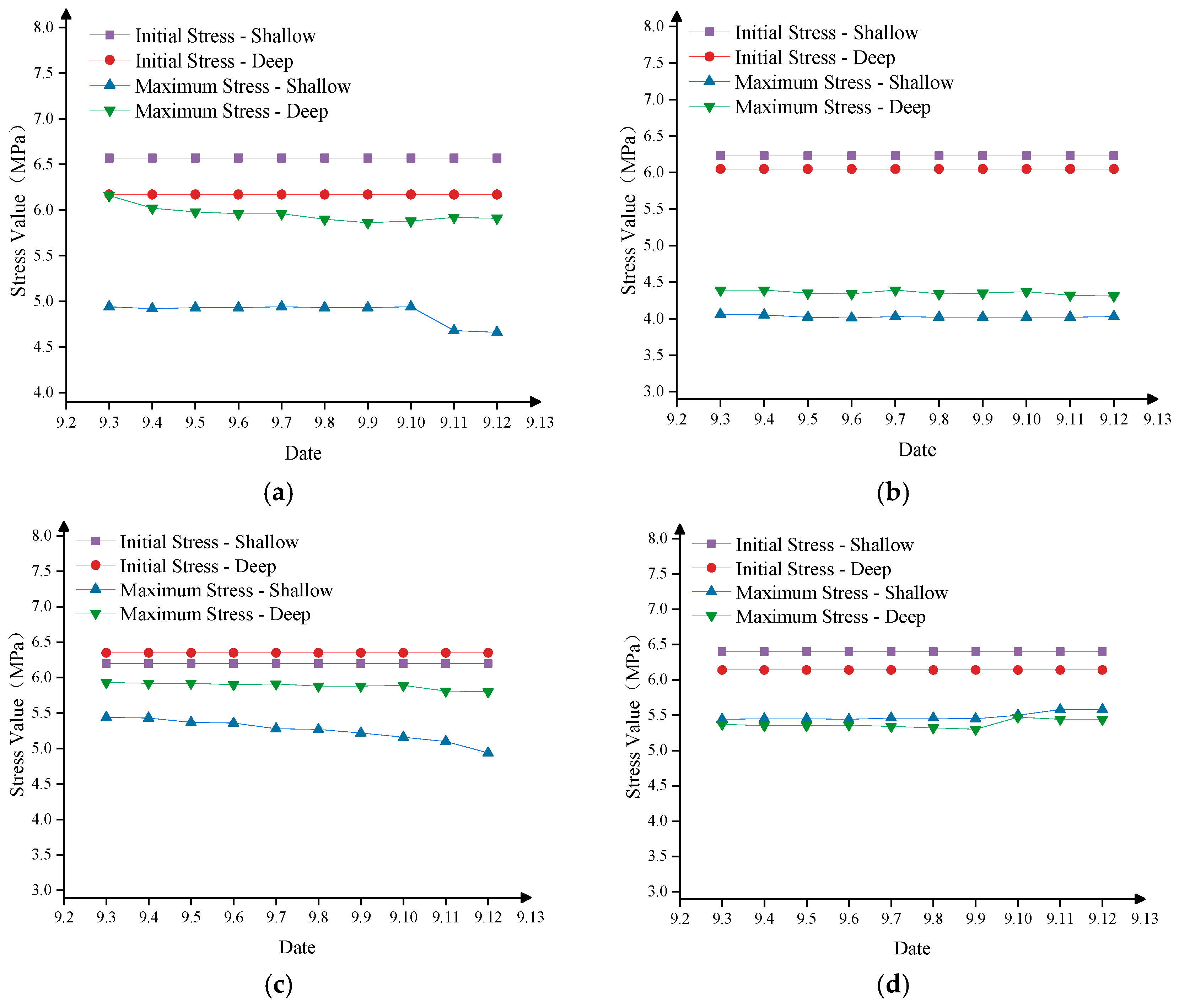
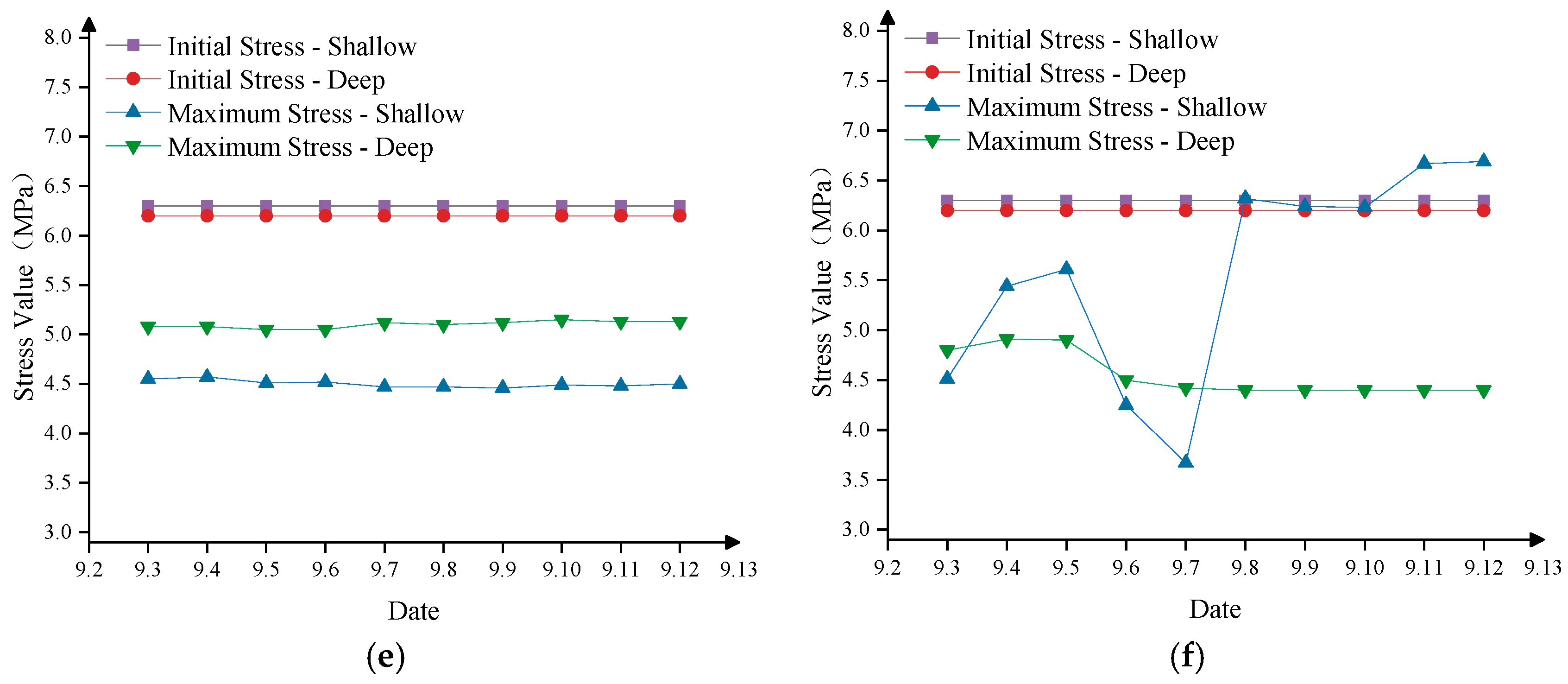
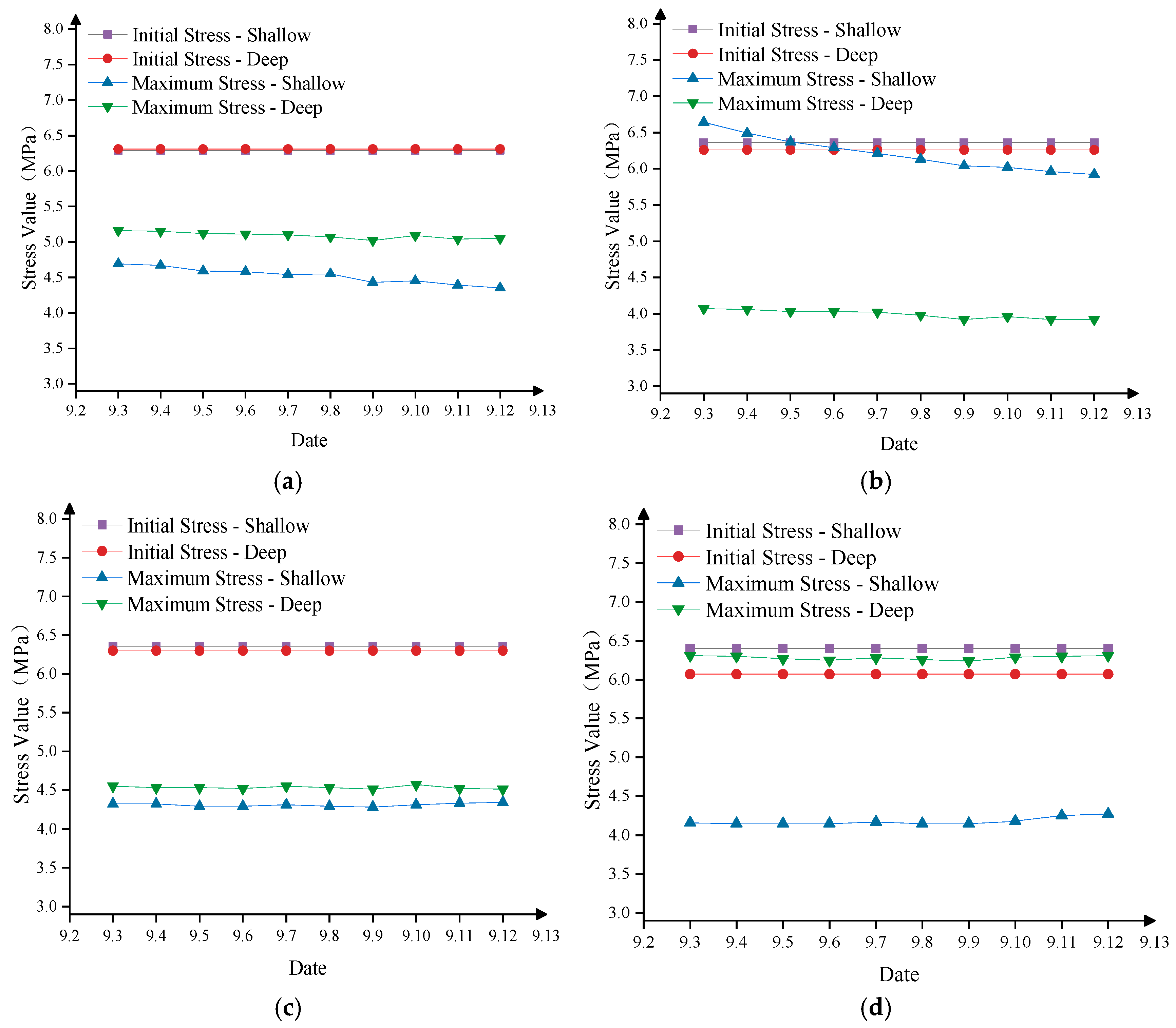

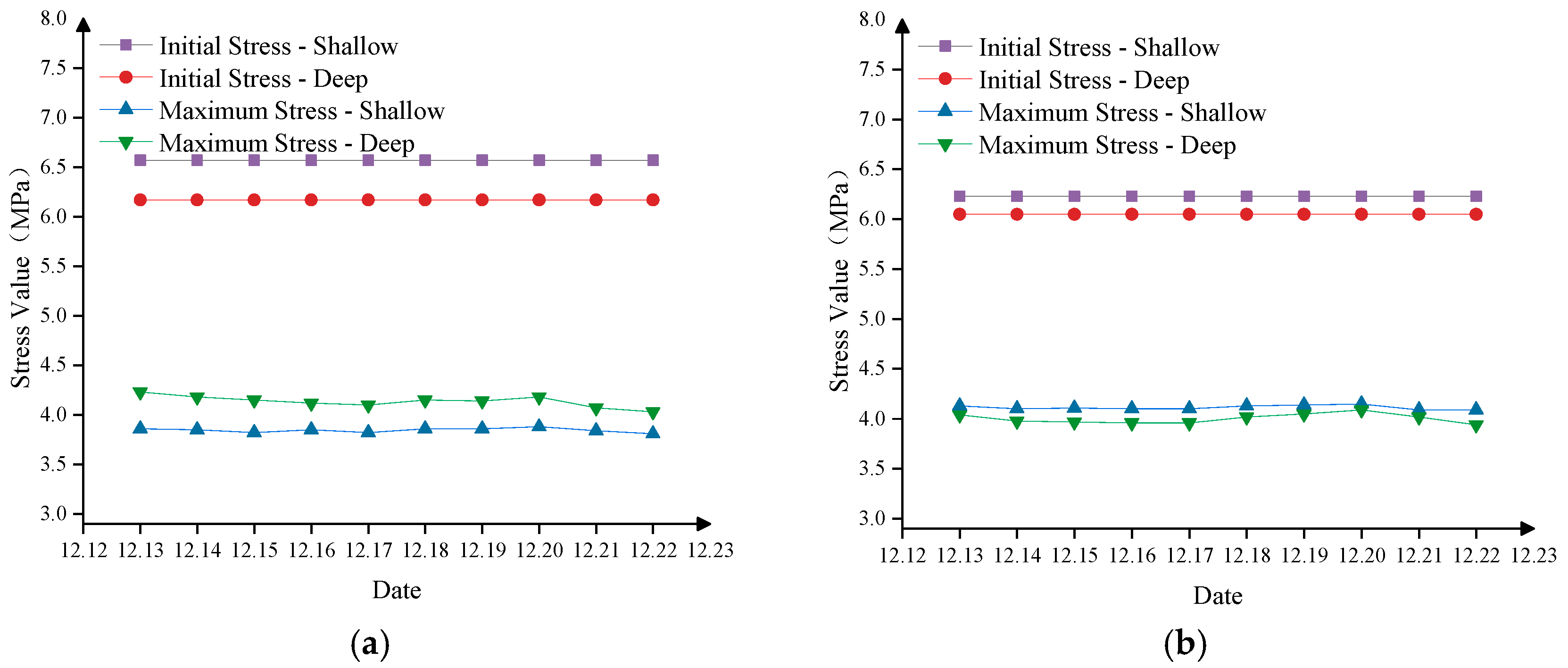

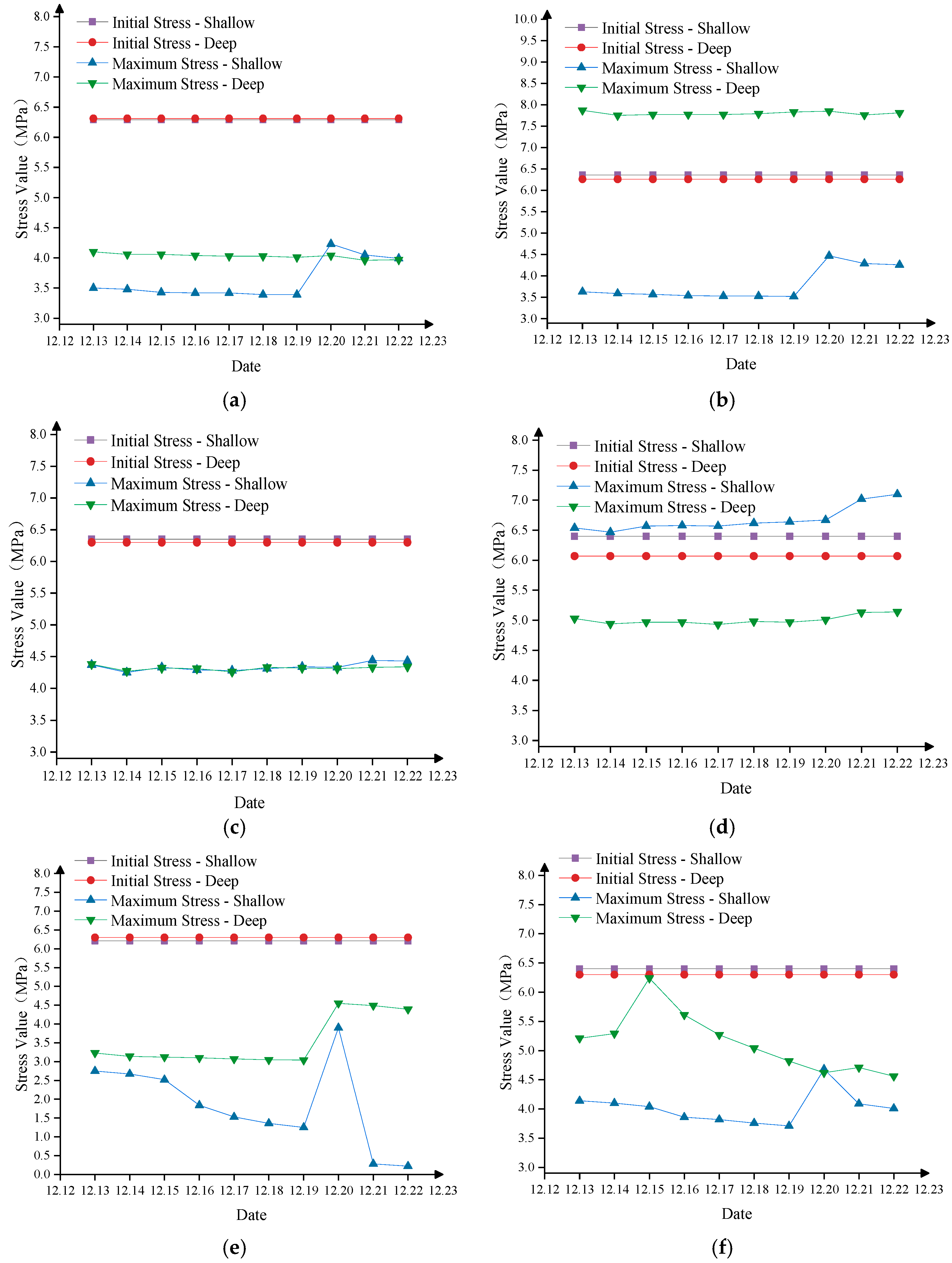
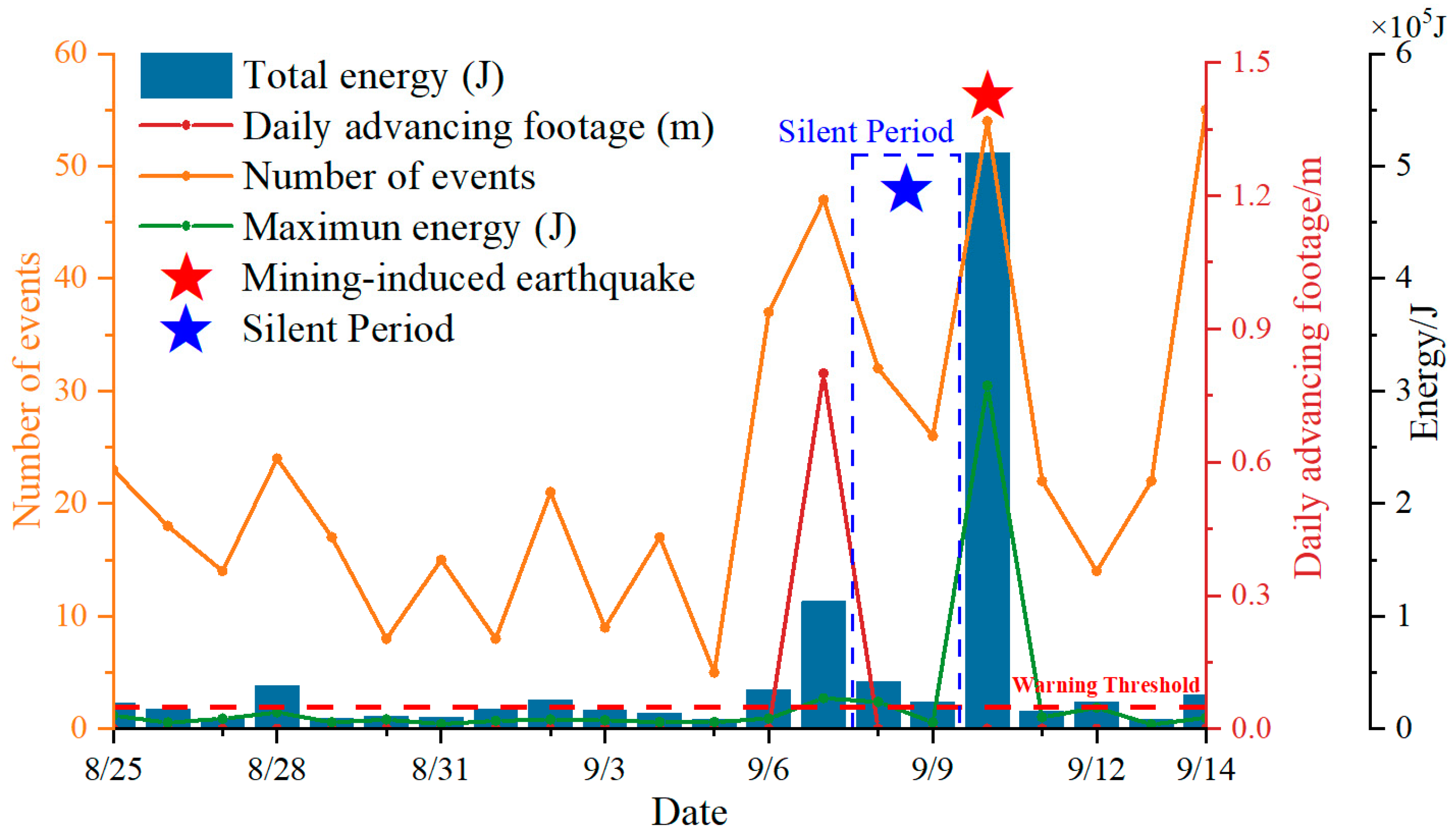
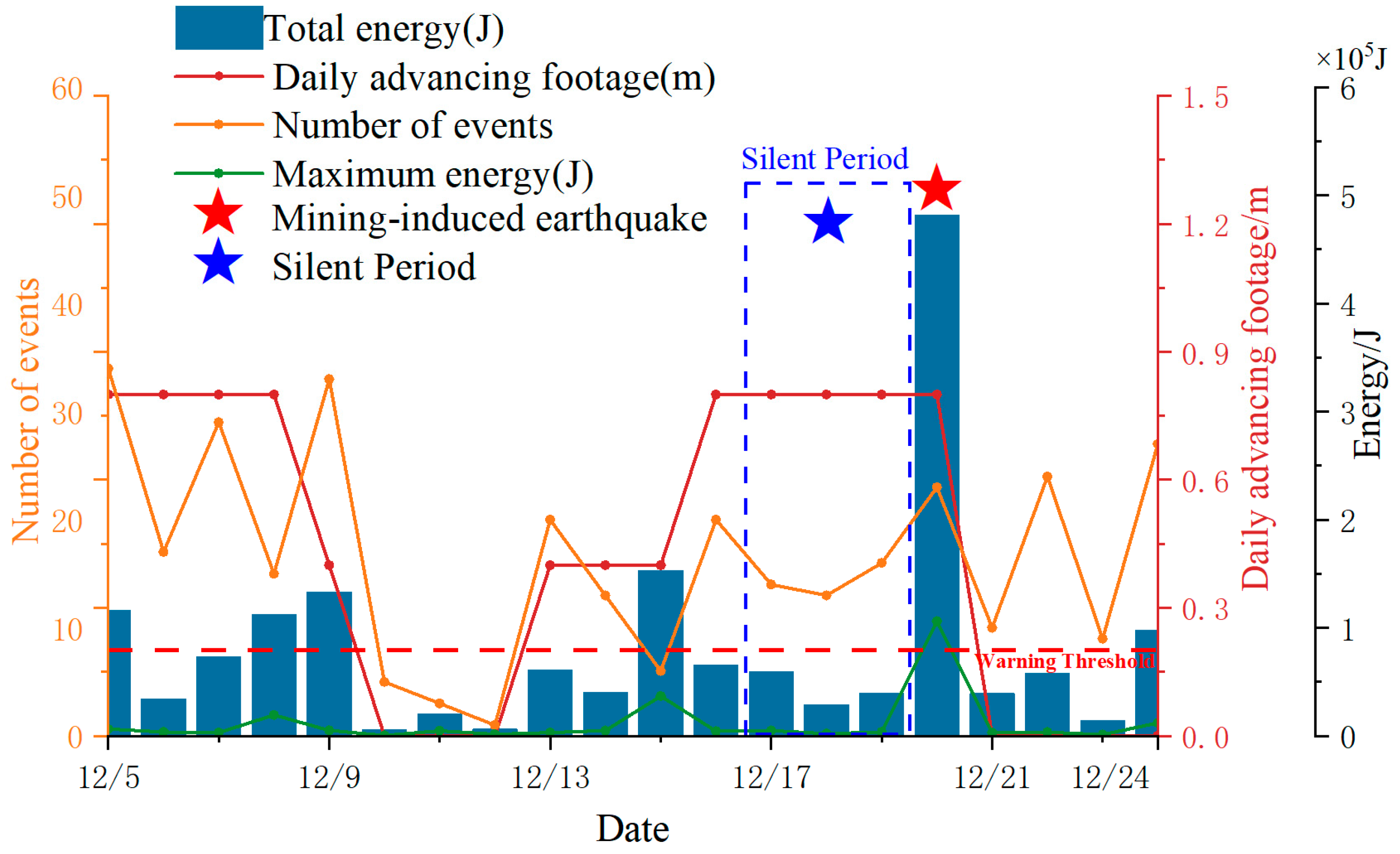
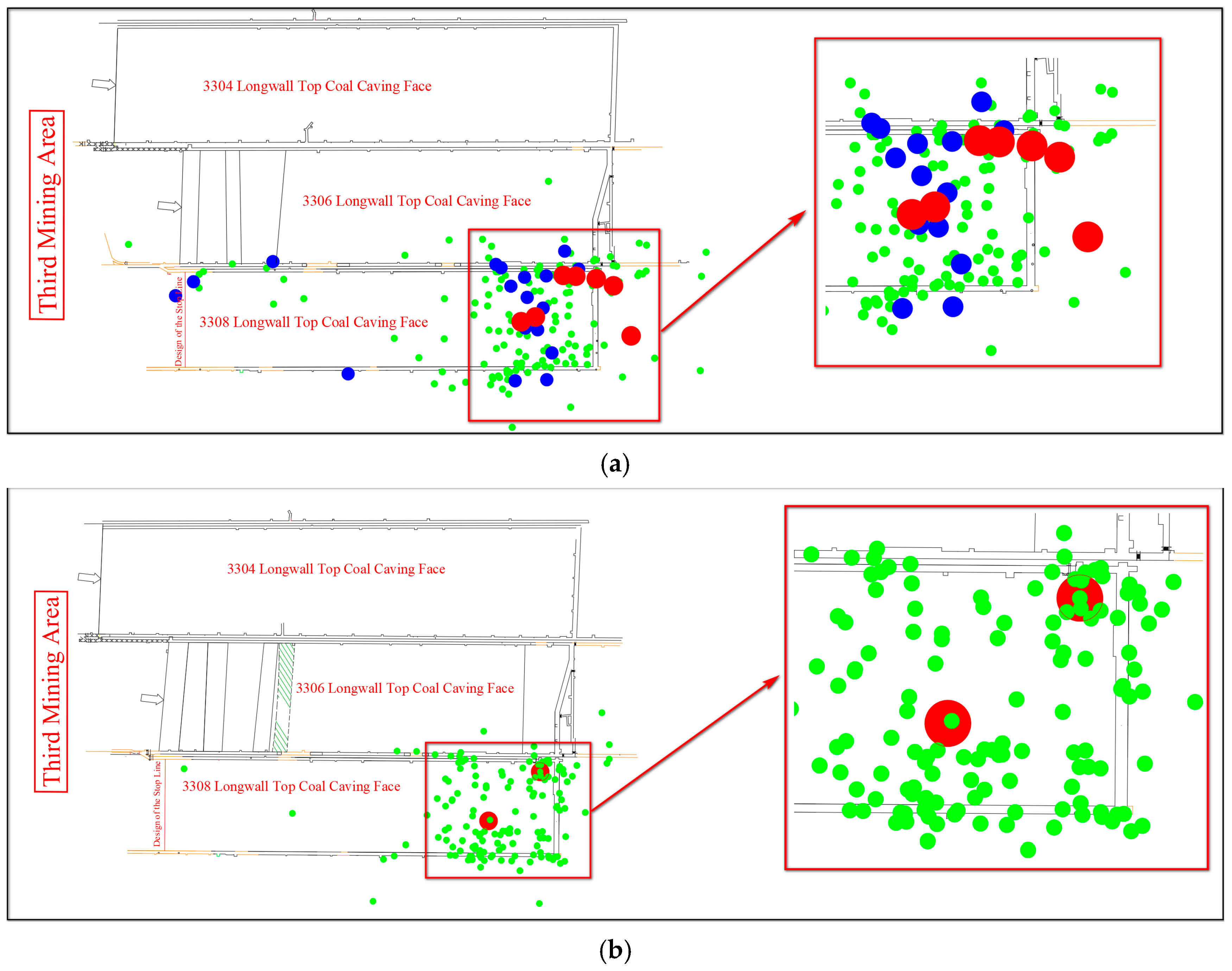




Disclaimer/Publisher’s Note: The statements, opinions and data contained in all publications are solely those of the individual author(s) and contributor(s) and not of MDPI and/or the editor(s). MDPI and/or the editor(s) disclaim responsibility for any injury to people or property resulting from any ideas, methods, instructions or products referred to in the content. |
© 2024 by the authors. Licensee MDPI, Basel, Switzerland. This article is an open access article distributed under the terms and conditions of the Creative Commons Attribution (CC BY) license (https://creativecommons.org/licenses/by/4.0/).
Share and Cite
Sun, W.; Wang, E.; Li, J.; Liu, Z.; Zhang, Y.; Qiu, J. Mining-Induced Earthquake Risk Assessment and Control Strategy Based on Microseismic and Stress Monitoring: A Case Study of Chengyang Coal Mine. Appl. Sci. 2024, 14, 11951. https://doi.org/10.3390/app142411951
Sun W, Wang E, Li J, Liu Z, Zhang Y, Qiu J. Mining-Induced Earthquake Risk Assessment and Control Strategy Based on Microseismic and Stress Monitoring: A Case Study of Chengyang Coal Mine. Applied Sciences. 2024; 14(24):11951. https://doi.org/10.3390/app142411951
Chicago/Turabian StyleSun, Weichen, Enyuan Wang, Jingye Li, Zhe Liu, Yunpeng Zhang, and Jincheng Qiu. 2024. "Mining-Induced Earthquake Risk Assessment and Control Strategy Based on Microseismic and Stress Monitoring: A Case Study of Chengyang Coal Mine" Applied Sciences 14, no. 24: 11951. https://doi.org/10.3390/app142411951
APA StyleSun, W., Wang, E., Li, J., Liu, Z., Zhang, Y., & Qiu, J. (2024). Mining-Induced Earthquake Risk Assessment and Control Strategy Based on Microseismic and Stress Monitoring: A Case Study of Chengyang Coal Mine. Applied Sciences, 14(24), 11951. https://doi.org/10.3390/app142411951




